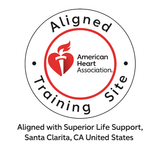Introduction
Cardiopulmonary resuscitation (CPR) is a critical life-saving technique that can significantly increase a person's chances of survival during cardiac emergencies. When performed promptly and correctly, CPR can help maintain blood flow and oxygen supply to vital organs until professional medical help arrives. However, despite its importance, there are several misconceptions surrounding CPR and automated external defibrillators (AEDs) that can lead to hesitation or incorrect actions during emergencies. In this blog, we will debunk common myths about CPR and AEDs, clarify their effectiveness, and provide accurate information to empower readers to confidently perform CPR when needed. Additionally, we'll emphasize the significance of staying up-to-date with the latest CPR guidelines to ensure the best outcomes.
Myth 1: CPR is only effective if performed by medical professionals.
One of the most prevailing myths about CPR is that it should only be performed by medical professionals. In reality, anyone can learn and perform CPR, and immediate action by a bystander can be the difference between life and death. Studies have shown that early bystander CPR can double or even triple the chances of survival for someone experiencing cardiac arrest.
The American Heart Association (AHA) and other leading organizations regularly conduct CPR training programs for laypeople to equip them with the necessary knowledge and skills to act confidently during emergencies. These courses cover basic life support techniques, including hands-only CPR, which eliminates the need for rescue breaths, making it simpler for untrained individuals to intervene.
Myth 2: Rescue breaths are more important than chest compressions in CPR.
Another common misconception is that rescue breaths are more critical than chest compressions during CPR. While rescue breaths are essential for providing oxygen to the victim's lungs, chest compressions are even more vital for maintaining blood circulation.
During cardiac arrest, the heart stops pumping blood, leading to a lack of oxygen supply to the brain and other organs. Chest compressions help to manually circulate blood, delivering oxygen to the brain and other vital organs until the heart can be restarted. Hands-only CPR, which involves uninterrupted chest compressions without rescue breaths, has proven to be highly effective and easier to perform for untrained individuals.
Myth 3: AEDs are dangerous to use and can cause harm to the victim.
Automated external defibrillators (AEDs) are portable devices designed to deliver an electric shock to the heart in cases of life-threatening cardiac arrhythmias, such as ventricular fibrillation. However, there is a misconception that AEDs can be harmful to the victim or the person using them.
In reality, AEDs are safe to use, and their built-in algorithms are designed to analyze the victim's heart rhythm and determine if a shock is needed. If a shock is necessary, the AED will prompt the user to deliver it, ensuring that the shock is administered at the right time and with the appropriate energy level. AEDs are equipped with safeguards to prevent shocks from being delivered if the device detects a normal heartbeat.
Myth 4: CPR is only suitable for adults and not for children or infants.
Another prevailing myth is that CPR should only be performed on adults and not on children or infants. The truth is that CPR is equally important and effective for people of all ages.
For children (aged one to puberty), the technique of CPR is similar to that used for adults, but the compression depth is adjusted to account for their smaller chests. Additionally, rescue breaths may be included in pediatric CPR, but hands-only CPR can also be effective.
For infants (up to one year old), CPR involves the use of two fingers for chest compressions and delivering rescue breaths through a gentle puff into the infant's mouth and nose.
It is crucial for caregivers, parents, teachers, and anyone who interacts with children regularly to receive proper training in pediatric CPR to be prepared for emergencies involving infants and children.
Myth 5: Once you perform CPR, the victim will always survive.
While CPR significantly increases the chances of survival for someone experiencing cardiac arrest, it does not guarantee a positive outcome in every case. The success of CPR depends on various factors, such as the underlying cause of cardiac arrest, the response time, the quality of CPR performed, and the availability of advanced medical care.
Immediate CPR buys valuable time until professional medical help arrives with advanced life support measures, such as defibrillation and medications. Even if the outcome is not always successful, performing CPR gives the victim a fighting chance at survival.
Staying Up-to-Date with the Latest CPR Guidelines
CPR guidelines are periodically updated based on the latest research and evidence-based practices. It is essential for everyone to stay informed about these updates to ensure that they are following the most current and effective techniques during emergencies.
The American Heart Association (AHA) and other reputable organizations regularly publish new guidelines for CPR and first aid. These guidelines may include changes in compression depth and rate, the use of AEDs, and advancements in techniques to optimize outcomes.
Conclusion
CPR and AEDs are invaluable tools in saving lives during cardiac emergencies. Debunking common myths and misconceptions about CPR and AED usage is crucial in empowering individuals to take swift and confident action when faced with such situations. Remember, anyone can learn CPR and perform it effectively. Hands-only CPR simplifies the process and removes the barrier of rescue breaths for untrained individuals.
AEDs are safe to use and are equipped with built-in algorithms to determine if a shock is necessary. Additionally, CPR is not limited to adults; it is equally important for children and infants, and age-appropriate techniques should be used accordingly.
Finally, staying up-to-date with the latest CPR guidelines is essential for ensuring that the best practices are followed during emergencies. By dispelling myths and promoting accurate information, we can empower individuals to be confident first responders, potentially saving lives and making a significant difference in cardiac arrest survival rates.


